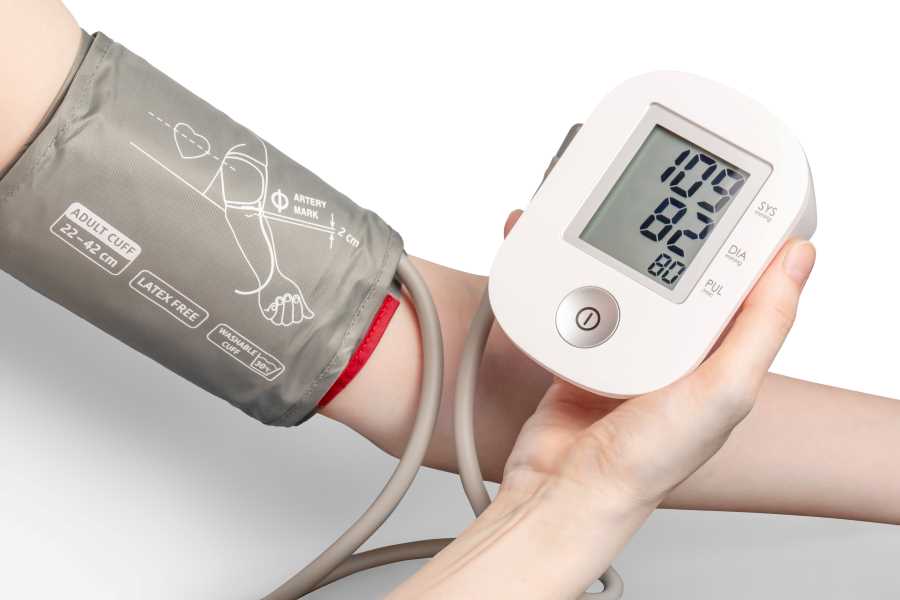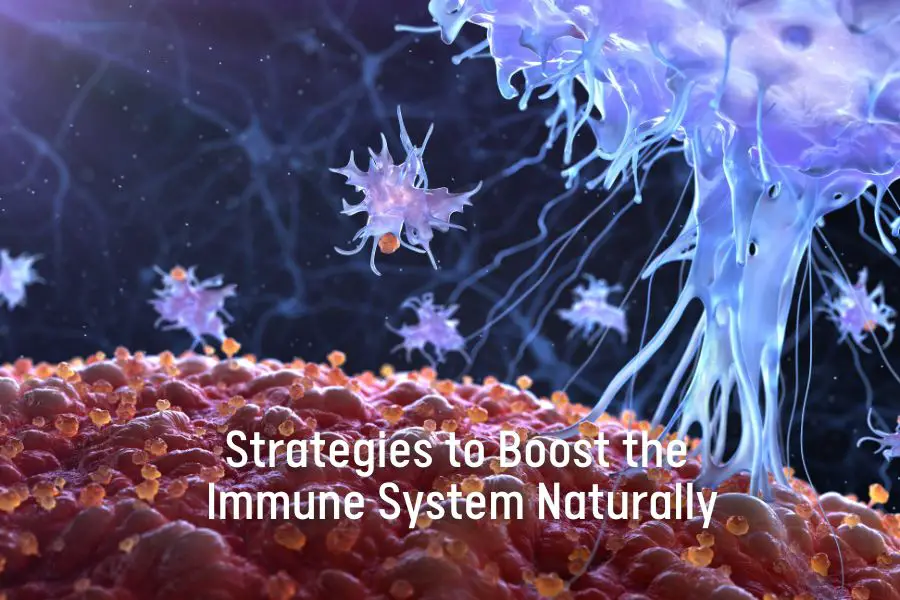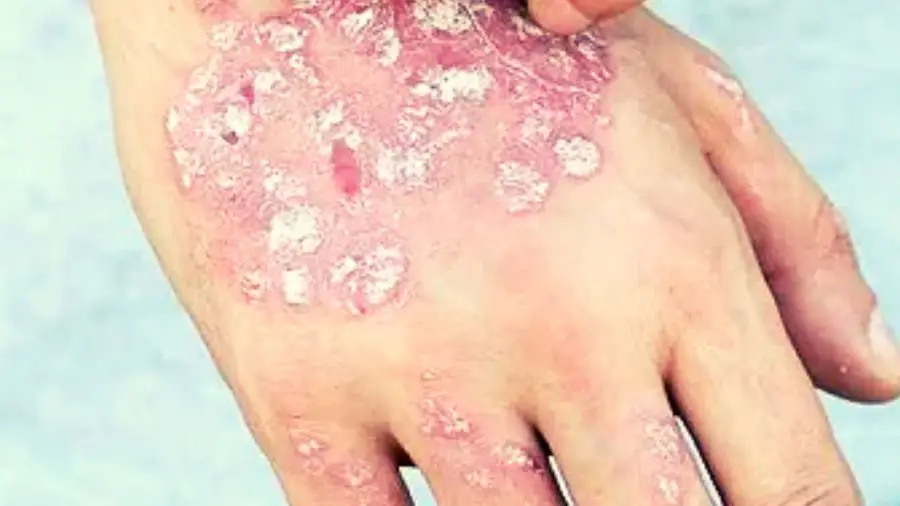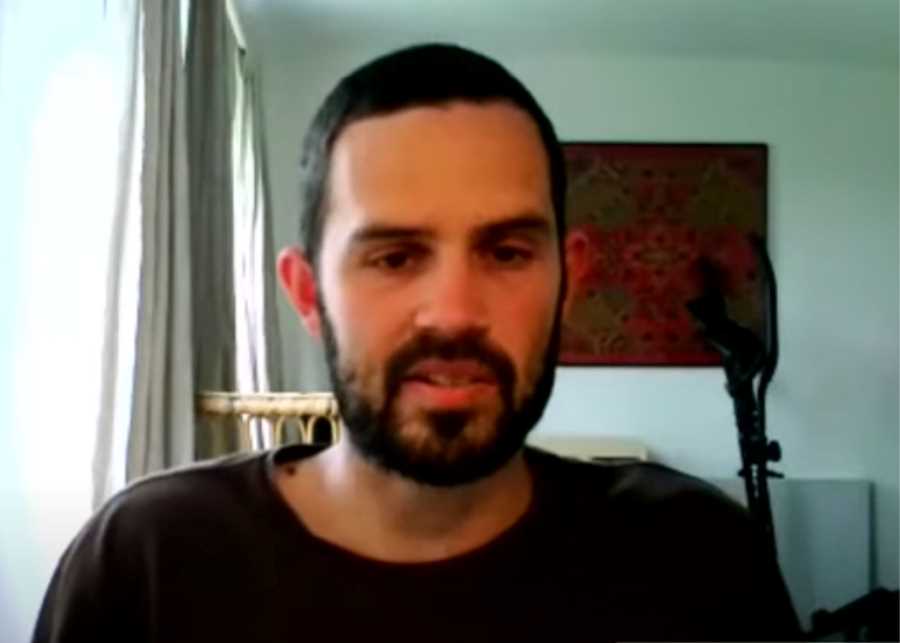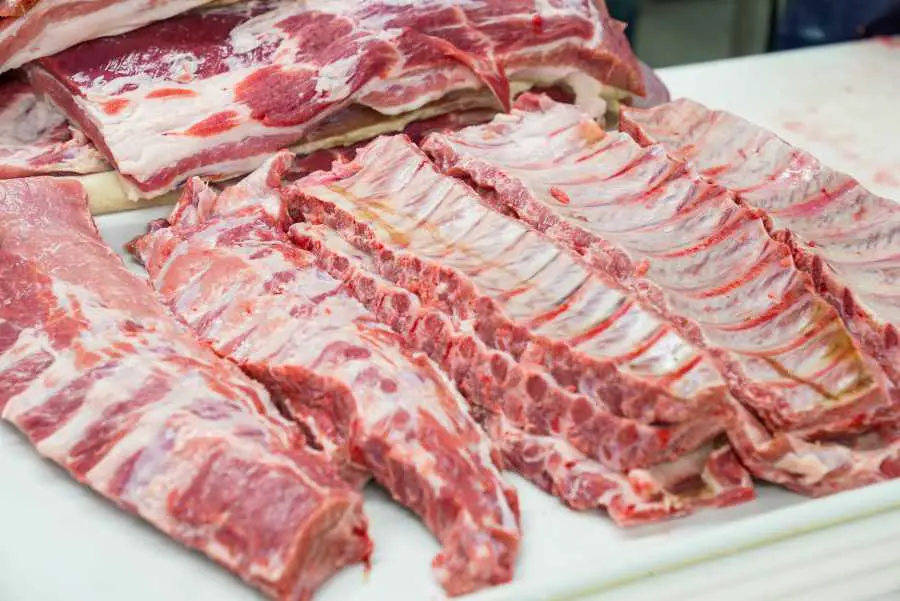People with high blood pressure or hypertension are sometimes advised to follow a low-fat diet and include plenty of fruits and vegetables in their diet.
So, does this mean that people with high blood pressure should avoid the carnivore diet due to its high fat content and the lack of fruits and vegetables?
The answer is no.
Available evidence indicates that, more than being safe, the carnivore diet can actually help people with high blood pressure resolve or improve their condition.
In this post, we will look at the basics of high blood pressure, how it is currently treated, and the evidence that the carnivore diet can actually help people lower their blood pressure.
What is blood pressure and how is it measured?
Blood pressure is the pressure of blood pushing against the walls of your arteries when it is pumped around the body by the heart. [1]
Blood pressure is measured in millimeters of mercury (mmHg). There are always two blood pressure readings, for example, 120/80 mmHg. [2]
The high number is the systolic blood pressure which is the pressure in the arteries when the heart beats and pumps out blood.
The low number is the diastolic blood pressure which is the pressure in the blood vessels when the heart relaxes before the next beat.
Blood pressure readings can vary throughout the day and can change due to things like stress, exercise, sleep, and temperature. [3]
Your blood pressure is considered normal when the readings are below 120/80 mmHg. [4]
Generally, your blood pressure is considered high when it is consistently 130/80 mmHg or higher, but some healthcare providers may adopt a higher threshold of 140/90 mmHg or higher. [5, 6, 7]
Below is a general guide:
| Classification | Systolic (mmHg) | Diastolic (mmHg) |
| Low | Less than 90 | Less than 60 |
| Normal | Less than 120 | Less than 80 |
| Elevated | 120 to 129 | 80 to 84 |
| Stage 1 hypertension | 130 to 139 | 85 to 89 |
| Stage 2 hypertension | Greater than 140 | Greater than 90 |
In the 2017 Guideline for the Prevention, Detection, Evaluation, and Management of High Blood Pressure in Adults by the American Heart Association, high blood pressure or hypertension is now defined as having a consistent reading of 130/80 mmHg or higher. [8]
With this definition, the prevalence of hypertension among U.S. adults is estimated to be around 46% or nearly half of adults in the US have hypertension. [9]
According to the CDC, high blood pressure was a primary or contributing cause of death for around half a million Americans in 2019. [10]
Globally, an estimated 1.28 billion adults aged 30-79 years worldwide have hypertension. [11]
Causes of high blood pressure
There are two types of high blood pressure: primary hypertension and secondary hypertension.
Primary hypertension
Primary hypertension (also called essential hypertension) refers to cases where no specific cause for high blood pressure can be identified. [12]
According to the American Heart Association, certain factors may increase the risk of developing high blood pressure or hypertension: [13]
- Being overweight or obese
- Excessive consumption of sodium
- Low sodium intake
- Low level of physical activities and physical fitness
- Excessive alcohol consumption
- Carrying certain pre-disposed genes.
Secondary hypertension
Secondary hypertension refers to cases where a specific cause of hypertension can be identified. [14]
In around 10% of adult patients with hypertension, underlying causes can be identified. [15]
Potential causes of secondary hypertension include: [16]
- Kidney diseases
- Hormone problems
- Obstructive sleep apnoea
- Alcohol
- Caffeine
- Drugs such as amphetamines, antidepressants, antipsychotics, decongestants, NSAIDs, immunosuppressants, contraceptive pills and some herbal supplements.
Current treatments for high blood pressure
Because, in most cases, underlying causes of high blood pressure (hypertension) could not be identified, current treatments are centered around lifestyle change recommendations based on epidemiological evidence.
Patients with high blood pressure are generally encouraged to: [17, 18, 19]
- Lose weight
- Reduce salt intake to less than 6 grams a day
- Eat a healthy diet (e.g. eat a low-fat, balanced diet and include plenty of fresh fruit and vegetables)
- Increase physical activity
- Moderate alcohol intake
- Reduce caffeine intake
- Quit smoking
- Reduce stress.
When lifestyle changes are not effective at lowering blood pressure and if your blood pressure remains consistently at 140/90 mm Hg or higher, your doctor will likely recommend that you take medications. [20]
Common medications for high blood pressure include: [21]
- Diuretics (thiazides, chlorthalidone, and indapamide) to force your kidneys to remove some salt from your body, lower fluid volume and, consequently, lower blood pressure
- Beta-blockers to make the heart beat at a slower rate and with less force
- Angiotensin-converting enzyme inhibitors to relax your blood vessels, which lowers your blood pressure
- Angiotensin II receptor blockers work in about the same way as angiotensin-converting enzyme inhibitors
- Calcium channel blockers relax blood vessels by reducing calcium entering blood vessel cells.
However, high blood pressure medicines can cause some serious side effects.
This is expected when you take drugs to interfere with the normal functioning of your body (e.g. forcing your heart to beat slower, relaxing your blood vessels, or forcing the kidneys to release sodium) in order to achieve better blood pressure readings while failing to address the underlying causes.
Common side effects of high blood pressure medications include: [22]
- Cough
- Diarrhea or constipation
- Dizziness or lightheadedness
- Erection problems
- Feeling nervous
- Feeling tired, weak, drowsy, or a lack of energy
- Headache
- Nausea or vomiting
- Skin rash
- Weight loss or gain without trying.
Is the carnivore diet okay for people with high blood pressure?
Available evidence indicates that the carnivore diet is not only safe for people with high blood pressure, but it can even help resolve their high blood pressure problems.
The mechanism under which the carnivore diet helps people lower their blood pressure is unclear. However, because weight loss has been associated with a decrease in blood pressure, one potential reason could be that the carnivore diet is effective at helping people to lose weight and therefore improve their high blood pressure problem.
In the section below, we will look at the available evidence.
Harvard survey
A recent survey on the carnivore diet experience of 2029 people was carried out by a team of researchers from Harvard Medical School and other institutions.
While 3,883 people participated in the survey, in the final findings, only 2029 participants who had been on the carnivore diet for at least 6 months were included.
Amongst those participants, 374 people (18% of the people surveyed) reported having high blood pressure and 93% of those said their hypertension problem had either been resolved or improved.
The remaining 7% reported that their hypertension problem remained unchanged while 0.3% (only one participant) reported that their hypertension problem got worse.
Overall, the carnivore diet has helped the overwhelming majority of survey participants improve their hypertension problems.
Steffanson study
In 1928, Vilhjalmur Stefansson, an Arctic explorer and anthropologist, and Karsten Anderson, a member of Stefansson’s expeditions participated in the Bellevue Hospital experiment where the two men ate meat only for one year under supervision.
The result of this experiment was published in the Journal of Biological Chemistry in February 1930 under the title “Prolonged meat diets with a study of kidney function and ketosis”. [23]
It was found that their year-long meat diet did not cause an increase in the men’s blood pressure.
In Karsten Anderson’s case, the diet even reduced his systolic blood pressure from 140 mmHg (stage 2 hypertension) to 120 mmHg (normal).
The meat diet did not cause any elevation in the blood pressure of these two men despite the popular view that meat is a definite factor in producing such a result.
V. S. maintained a systolic pressure of 105 mm. and a diastolic pressure of 70 mm. throughout the entire period.
K. A. registered 140 mm. systolic and 80 mm. diastolic pressure at the beginning and 120 mm. systolic and 80 mm. diastolic pressure at the end of the year.
The individual variations in pressure during the year were not significant.
McClellan and Du Bois (1930)
Eskimo study
In an expedition to Greenland in 1908, August and Marie Krogh estimated that the Greenland Eskimos consumed approximately 282 grams of protein, 135 grams of fat, and 54 grams of carbohydrate per day. [24]
Thomas (1927), based on an examination of 142 Eskimos, found no evidence of elevated blood pressure and rarely any evidence of kidney disease and concluded that a carnivore diet does not produce renal or vascular disease. [25]
When the Greenland Inuit adopted Western-style diets, their blood pressure increased. [26, 27]
This shows that the Inuit’s healthy blood pressure levels are not due to special genetics but lifestyle factors.
Testimonials
There are numerous testimonials on the positive impacts of the carnivore diet on hypertension that you can find on Dr. Shawn Baker’s website. [28]
Below are some examples. [29, 30]
Mark improved joint pain, muscle mass and blood pressure on the carnivore diet
Mark, aged 56, had high blood pressure, high cholesterol, joint pain, fatigue, and fluctuating moods and energy levels.
He was also overweight. He began to put on weight in his 20s and it got worse as he got older.
At the age of 35, he weighed 205 pounds and couldn’t shake it off.
On the advice of a dietician, he increased his fiber intake, ate more fruits and vegetables and added 20-30 minutes of exercise daily. This didn’t help.
He eventually found the ketogenic diet, lost 45 pounds, increased energy levels, and reduced joint pain within one year.
He decided to try the carnivore diet and found that, after one month, the rest of the joint pain and stiffness in his toes disappeared. He also had more muscle and his blood pressure was in the low normal.
Spence lost 100 pounds and resolved his hypertension
Spence was obese and suffered from hypertension, inflammation, fatigue and digestive tract issues.
He was gaining weight rapidly and weighed 300 pounds in February 2020.
He lost 100 pounds after being on the carnivore diet for 1 year.
He also resolved other health problems and gained muscle mass with exercises.
Botond lost weight, improved blood pressure, joint pain and energy levels
Botond was obese from his childhood and had tried different diets to lose weight but failed.
He was blamed for not having enough mental toughness to lose weight successfully.
After each failed diet, he put on more weight and became sicker.
He developed joint pain and had low libido and low energy.
He constantly felt bloated, had acid reflux, and caught the flu several times each winter.
At the age of 28, he had high blood pressure and was developing non-alcoholic liver disease.
After two years on the carnivore diet, he no longer had hypertension and his liver is healthy. He also improved his energy levels and libido.
Joette came off 24 medications and improved celiac disease, IBS, and autoimmune conditions
Joette had a gastric lap band installed 18 years ago. Seven years later she had to have it removed due to complications and gained weight back immediately.
Due to calorie restriction as a result of the gastric band, she was poorly nourished and had many health issues and symptoms.
She was sent to various specialists including a rheumatologist, a pulmonologist, a cardiologist, a hematologist and a neurologist who eventually diagnosed her with something and began to prescribe her medications.
She was on 26 different medications which were supposed to help her get better but instead caused her to feel worse and her weight ballooned up to 234 pounds.
Her list of diagnoses includes depression, rheumatoid arthritis, lupus, chronic fatigue, Sjogren’s Syndrome, celiac disease, hypertension, sleep apnea and neuropathy.
She started the ketogenic diet in January 2017 and was on it for around a year and a half. She lost 80 pounds and had her celiac disease under control.
She eventually switched to the carnivore diet and began to see further improvements.
She was able to come off 24 out of 26 medications and stop using her CPAP machine, inhaler and infusions from the doctors.
Her celiac disease and irritable bowel syndrome are under control.
She no longer has hypertension that used to be controlled with 4 different medications. Her three autoimmune conditions are also in remission.
Chris lost 220 pounds and reversed all serious health problems
Despite working in the health and wellness industry for 25 years, Chris was unhealthy. He put on weight over time and gradually became sicker.
By the time he was in his 40s, Chris had gout, kidney stones, diverticulitis and experienced daily pain.
His weight eventually reached 500 pounds.
He tried many diets and even became vegetarian for a while. He also spent a lot of money on supplements and alternative therapies.
But nothing worked. He became sicker, more disabled and depressed. He even needed a CPAP machine to keep him breathing.
Chris started a strict ketogenic diet in 2018, lost some weight and felt better but most of his health problems remained.
When he found out about the carnivore diet, he decided to give it a go because he reckoned he had nothing to lose.
Chris began the carnivore diet on 1 December 2018 and since then had experienced an amazing transformation.
He lost weight. His diverticulitis, diabetes, kidney stones, gout, leg edema, ocular migraines, prostate and other health issues completely resolved.
He was off all medications and supplements. His depression and anxiety were gone. He felt the best he had ever been in his life and has now become a health coach.
Other testimonials
If you would like to read more amazing stories of health transformation like those, please check out Dr. Shawn Baker’s website or read anecdotes in his book The Carnvore Diet (no affiliate).
Why the carnivore diet helps resolve high blood pressure problems
Overweight and obesity have been identified as leading risk factors for high blood pressure and weight loss can help lower blood pressure. [31]
Being overweight or obese can increase the risk of developing hypertension primarily because of its negative impact on kidney function which can lead to an increase in sodium reabsorption by the kidneys. [32]
Because the carnivore diet has the potential to help people lose weight effectively and improve their insulin sensitivity as well as overall metabolic health, this could be the main reason why the carnivore diet can help people lower their blood pressure.
When one loses weight and fat, especially the abdominal fat that wraps around the internal organs, the pressure due to the physical compression of the kidneys by the fat deposit is reduced.
In addition, because animal-based food is the most nutrient-dense food, the carnivore diet can potentially help improve kidney functions and overall health and hence help control hypertension effectively.
Conclusion
Available evidence indicates that the carnivore diet is safe and even beneficial for people with high blood pressure.
While some health authorities advise that people with high blood pressure should follow a low-fat diet with plenty of whole grains, fruit and vegetables, a meat-based diet has actually helped many people lower their blood pressure naturally.
If you find this post helpful, please consider sharing this post and my site with your family, friends, and followers. That would be much appreciated. Please also check out my library of articles on the carnivore diet here which is updated regularly.
Disclaimer: The information in this post is for reference purposes only and not intended to constitute or replace professional medical advice. Please consult a qualified medical professional before making any changes to your diet or lifestyle.
Photo credit: Mockup Graphics on Unsplash

